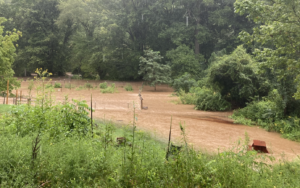Steps for Farms Assessing Flood Damage
go.ncsu.edu/readext?816011
en Español / em Português
El inglés es el idioma de control de esta página. En la medida en que haya algún conflicto entre la traducción al inglés y la traducción, el inglés prevalece.
Al hacer clic en el enlace de traducción se activa un servicio de traducción gratuito para convertir la página al español. Al igual que con cualquier traducción por Internet, la conversión no es sensible al contexto y puede que no traduzca el texto en su significado original. NC State Extension no garantiza la exactitud del texto traducido. Por favor, tenga en cuenta que algunas aplicaciones y/o servicios pueden no funcionar como se espera cuando se traducen.
Português
Inglês é o idioma de controle desta página. Na medida que haja algum conflito entre o texto original em Inglês e a tradução, o Inglês prevalece.
Ao clicar no link de tradução, um serviço gratuito de tradução será ativado para converter a página para o Português. Como em qualquer tradução pela internet, a conversão não é sensivel ao contexto e pode não ocorrer a tradução para o significado orginal. O serviço de Extensão da Carolina do Norte (NC State Extension) não garante a exatidão do texto traduzido. Por favor, observe que algumas funções ou serviços podem não funcionar como esperado após a tradução.
English
English is the controlling language of this page. To the extent there is any conflict between the English text and the translation, English controls.
Clicking on the translation link activates a free translation service to convert the page to Spanish. As with any Internet translation, the conversion is not context-sensitive and may not translate the text to its original meaning. NC State Extension does not guarantee the accuracy of the translated text. Please note that some applications and/or services may not function as expected when translated.
Collapse ▲
- Document the damage. Take photos, assess and tally losses, and record and store this information. This is often the most impactful way to verify the extent of loss.
- Report your damage – several agencies can assist, however, it is up to the grower to reach out and provide information:
- For CROP/FIELD DAMAGE – Contact the Buncombe/Madison County Farm Service Agency at 828-649-9099, ext. 2
- For STREAMBANK DAMAGE – Contact the Buncombe Soil & Water Conservation Service at 828-250-4785
- NRCS is also assisting with STREAMBANK DAMAGE reports – for Buncombe/Haywood counties call 828-421-9795
- N.C. Department of Agriculture and Consumer Services may also be able to assist with support – Call 828/558-1074
It’s possible that this flooding event may warrant special disaster funding for farmers in the future, and the best way to access potential funding is to document damage as soon as possible.
Food Safety and Flooded Crops
Beyond the immediate damage of floodwaters, growers must evaluate crops to determine what, if anything, can be salvaged. Floodwaters are highly contaminated with a multitude of adulterants and harmful microscopic organisms. For producers of edible crops, any edible crop that has been exposed to flood waters is considered adulterated and should not enter human food channels. The FDA provides clear guidance on assessing crops, and steps growers should take when produce has been contaminated by floodwaters.
For more detailed information on these steps, please visit Information Regarding Flooded Produce. The FDA Guidance for the Produce Industry is another useful reference for growers.




